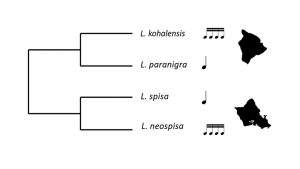**The AGA grants EECG Research Awards each year to graduate and post-doctoral researchers who are at a critical point in their research, where additional funds would allow them to conclude their research project and prepare it for publication. EECG awardees also get the opportunity to hone their science communication and write three posts over their grant tenure for the AGA Blog. In the first in the series, our EECG awardees write about their research and their interests as an ’embarkation’.

About the Author: Hayden Waller is a behavioral geneticist and fifth year PhD student at Cornell University. He works under the tutelage of Dr. Kerry Shaw on the genetic basis of courtship song variation in the Laupala species radiation on Hawaii. Follow him on Twitter @tbh_i_dont_know.
If you’re anything like me, you find the following to be an extraordinarily wild concept: The body of every animal on the planet is comprised of cells that each contain little instruction manuals for producing proteins that in turn drive many (most?) of the behaviors they perform. While this idea is certainly far from novel, it ought not to be considered any less stunning today than it was when it was first realized.
My interest in behavioral genetics drives my PhD work, in which I focus primarily on the rapid radiation of Laupala crickets on the islands of Hawaii. There are thirty-eight described species in the genus, all of which are quite morphologically and ecologically similar to one another. There are several phenotypes that vary dramatically between species, however, the most obvious of which is the rhythmicity of the male courtship song and the female’s preference thereof. Indeed, species can accurately be identified based exclusively on their location and courtship song. The reason one must take location into account is that throughout the radiation we have witnessed repeated convergent evolution of similar courtship song rhythms (i.e. fast, slow, or intermediate) that do not appear to have a phylogenetic basis (i.e. sister species often have wildly different phenotypes and are more behaviorally similar to more distantly related species (Fig. 1).

We are beginning to understand the genetic basis of this courtship song variation in greater detail every year, from the genetic architecture of the trait to individual candidate genes underlying variation (Xu & Shaw 2019, Blankers et al. 2019, Waller et al. in prep). However, we know next to nothing about the role of gene expression in this rapid radiation. It was this gap in knowledge that inspired me to seek out funding to pursue a project aimed at unraveling some of the mystery. In the coming months, I will begin to answer the question of whether or not Laupala demonstrates convergent evolution in gene expression in concert with the convergent evolution of courtship song phenotypes we see across the radiation.
Through RNA-sequencing of four species (Fig. 1), I will identify the subset of genes whose expression patterns are consistent with the expectations predicted by their phylogenetic relationships. Then, I will zoom in on the subset of genes that are not consistent with phylogenetic expectations, paying special attention to those whose expression patterns reflect convergence based on behavioral phenotype. Once these genes are in hand, I can test whether certain GO terms are overrepresented, as well as if they are statistically overrepresented under our previously identified QTL peaks. This experiment allows me to rigorously address the question of whether convergent evolution in gene expression evolves in parallel with convergent evolution of pulse rate phenotypes!
References



